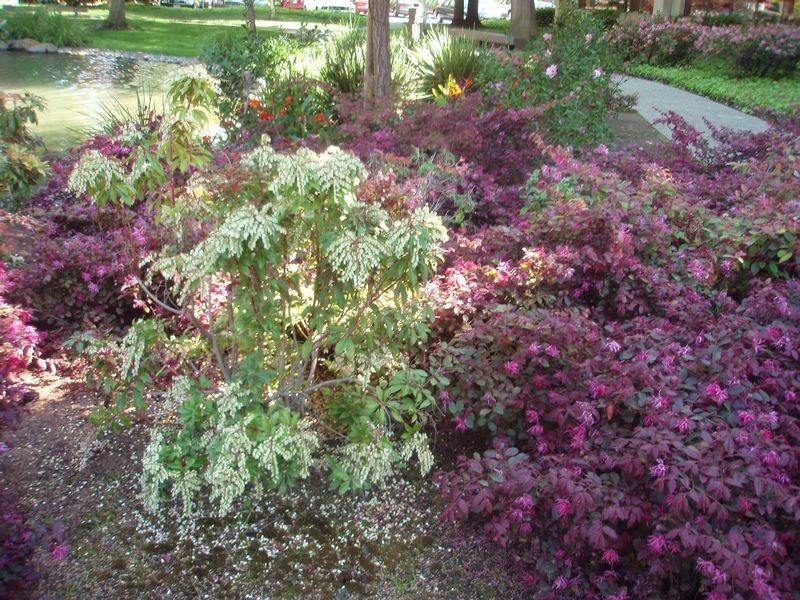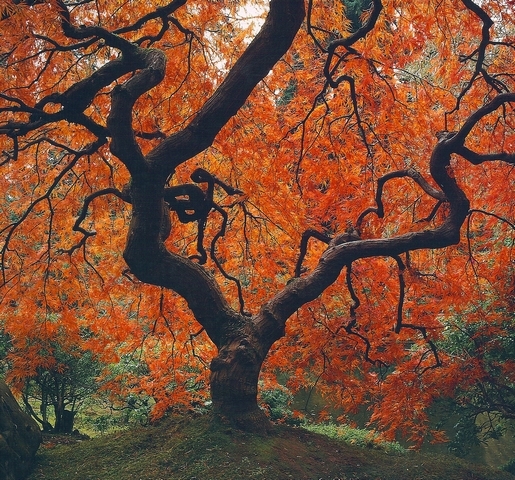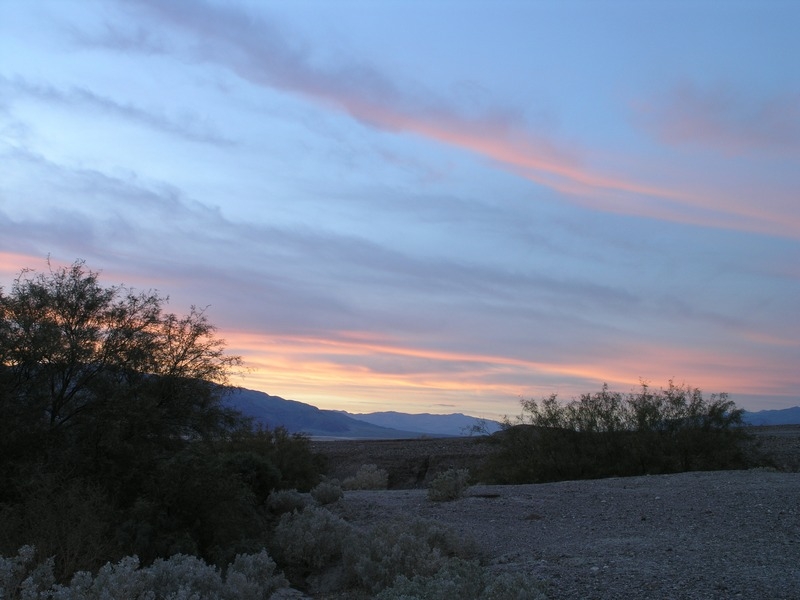Some of us live in mostly shade and some of us in the sun. The choices for sunny locations are many but those of us who garden in shady or partially shady places have a tougher time finding good, reliable plants.
Looking back over the years, I find that time and again I use one of the following plants in a design for a shady garden. Sure, every garden is different; different look, different soil, different degree of shade, but it’s surprising how often one of these plants plays a starring or supporting role in a vignette or border.
I call them Jan’s Top 10 Plants for Shade.

#1 Loropetalum chinense or Fringe flower. This handsome evergreen shrub comes in two versions: green foliage with white flowers or burgundy foliage with raspberry flower clusters. Flowering is heaviest in the spring but some bloom is likely throughout the year. I place this plant in the foreground where you can appreciate it’s graceful shape. It looks great as an accent or in a raised bed. The burgundy form would add color to a woodland garden and they even do well in a container on the patio. You can prune it to any size but please don’t turn it into a tight ball and ruin it’s shape. Another plus is that it is not attractive to deer.
#2 Liriope or Lily Turf. Another deer resistant perennial I use a lot as a ground cover , at the edge of a path, or in a mixed border. Evergreen grasslike leaves form tufts 18" tall. They do well along streams or garden pools and compete well with the roots of other plants like at the base of trees or shrubs. Flower spikes, usually purple, are quite showy. ‘Big Blue’ is a popular variety that does well in dry shade. ‘Silvery Sunproof‘ has green strappy leaves with gold stripes that age to white and can take sun. In shade they stay golden, which is really pretty.
#3 Heuchera or Coral Bells. There are so many varieties of this perennial these days I hardly know where to start. Whether native or a hybrid their flower spikes are a hummingbird favorite. Colorful foliage, often ruffled or variegated, can be silver, amethyst, caramel or lime green. Combine a tawny variety like ‘Caramel‘ with the chartreuse foliage of ‘Citronella‘ in front of taller perennials or as a border edging. They make good container plants, too. Plant them where they get a little afternoon shade and they’ll be happy.
#4 Pieris japonica or Lily of the Valley shrub. An evergreen shrub with year round interest, this plant blooms early in late winter though early spring , and is covered with little bells for several months. Starting in fall , when reddish flower buds appear, through summer as new foliage emerges with a red tint there is always something attractive happening with this plant. Deer resistant also.
#5 Dryopteris erythrosora or Autumn fern. If you’re looking for brighten up a shady area, this is the fern for you. New fronds emerge a coppery color unlike any other fern. Although they appreciate regular water, they will tolerate dry shade in a pinch. Deer don’t like ferns either.
#6 Hydrangea quercifolia or Oakleaf hydrangea. Huge showy leaves resembling oaks, turn bronze or crimson in the fall. White flower clusters , 8" long, bloom in late spring and early summer, turning pinkish as they age. They are attractive if left on the plant for the rest of the season. This deciduous shrub grows to 6 ft tall and can also be grown in containers.
#7 Hakonechloa or Japanese forest grass. The most widely grown and I think the most beautiful variety is ‘Aureola‘. Use this graceful, chartreuse colored grass to lend a classy touch to containers or as an architectural accent to a border or along a path. In cool weather, the leaves turn pinkish and blend with your other fall foliage.
#8 Nandina or Heavenly bamboo. Not a true bamboo, this hardy, easy to grow shrub, comes in many forms. Some are ground covers, some hedges, some narrow accents in restricted places. Many have bright orange-red foliage in the winter and deer don’t like them. . It can grow in dry areas and you can harvest the sprays of berries for a holiday wreath.
#9 Cornus florida or Flowering dogwood. Check out ‘Cherokee Chief‘ to provide vivid red fall foliage color to your garden as well as scarlet fruit that hangs on the trees in the winter. This variety bears deep rosy bracts that nearly cover the tree in spring. Use this small handsome tree as a focal point in the garden.
#10 Acer palmatum or Japanese maple. ‘Bloodgood‘ is probably the brilliant deep scarlet red maple you’re seeing around town. In the spring and summer foliage is deep red but in the fall- look out -it turns neon red. Growing to only 15 ft, this small tree can be placed anywhere , even in a container.
There are many other great plants that come to mind that I also use and like. Pacific coast iris, campanula, bush anemone, to name a few. This is a good time to add some new plants to the shady spots in your garden.
 Leaves change color when they are going into winter dormancy. When nights get long enough, leaves develop a corky layer of cells between the leaf stalk and the woody part of the tree. This slows the transport of water and carbohydrates. The manufacture of chlorophyll is slowed and the green color of the leaves begins to fade, allowing the other pigments to show through. Since the transport of water is slowed down, food manufactured by the remaining chlorophyll builds up in the sap of the leaf and other pigments are formed which cause the leaves to turn red or purple in color, depending on the acidity of the sap.
Leaves change color when they are going into winter dormancy. When nights get long enough, leaves develop a corky layer of cells between the leaf stalk and the woody part of the tree. This slows the transport of water and carbohydrates. The manufacture of chlorophyll is slowed and the green color of the leaves begins to fade, allowing the other pigments to show through. Since the transport of water is slowed down, food manufactured by the remaining chlorophyll builds up in the sap of the leaf and other pigments are formed which cause the leaves to turn red or purple in color, depending on the acidity of the sap. 
 After returning, I’m struck with the lushness of our subtropical home. You probably get this same feeling when you get back from a vacation. We live in paradise. Whether you live in oak woodlands, chaparral, or a redwood / mixed evergreen forest we are blessed to live here. We are thankful for our neighbors and community, our flora and fauna, our wonderful climate and our gardens. I came across this poem of Thanksgiving and thought you might like it, too.
After returning, I’m struck with the lushness of our subtropical home. You probably get this same feeling when you get back from a vacation. We live in paradise. Whether you live in oak woodlands, chaparral, or a redwood / mixed evergreen forest we are blessed to live here. We are thankful for our neighbors and community, our flora and fauna, our wonderful climate and our gardens. I came across this poem of Thanksgiving and thought you might like it, too.  of flowers if you’re lucky. Mexican bush sage are still blooming as are lion’s tail, maybe a few cosmos, Japanese anemones and asters. Ornamental oregano holds up well , too, especially the variety Santa Cruz. Foliage can be a key player and might be found from smoke bush, ornamental grass, purple hopseed, crape myrtle, Chinese pistache, oaks, maples and liquidambar. Dogwood leaves would be beautiful as would ornamental pear. Berry accents are a staple for a fall bouquet and you might have nandina, cotoneaster, hawthorn, dogwood or crabapple in your garden. Go out and fill a brown shopping bag with whatever strikes your fancy to create a beautiful fall bouquet to give or dress up your own table or entry. Your arrangement should last about 4-7 days in a moderately cool room.
of flowers if you’re lucky. Mexican bush sage are still blooming as are lion’s tail, maybe a few cosmos, Japanese anemones and asters. Ornamental oregano holds up well , too, especially the variety Santa Cruz. Foliage can be a key player and might be found from smoke bush, ornamental grass, purple hopseed, crape myrtle, Chinese pistache, oaks, maples and liquidambar. Dogwood leaves would be beautiful as would ornamental pear. Berry accents are a staple for a fall bouquet and you might have nandina, cotoneaster, hawthorn, dogwood or crabapple in your garden. Go out and fill a brown shopping bag with whatever strikes your fancy to create a beautiful fall bouquet to give or dress up your own table or entry. Your arrangement should last about 4-7 days in a moderately cool room. 
 g you enjoy.
g you enjoy.